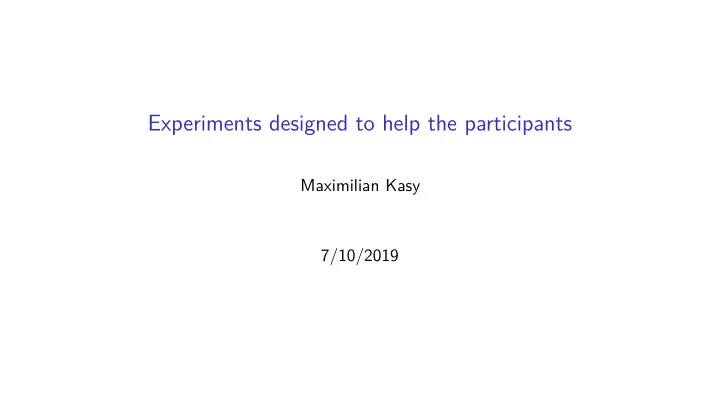

Experiments designed to help the participants Maximilian Kasy 7/10/2019
Why experiments? ◮ Are your programs effective in helping refugees? ◮ How to find out? ◮ Possibility 1: Compare the outcomes of those who got the programs to others who didn’t. ◮ Problem: These groups might be different for other reasons. ◮ Think about a doctor prescribing a medical treatment. ◮ Then the patients who got the treatment might die more often. ◮ But only because they were more sick to begin with! ◮ “Selection problem.”
The standard way of doing experiments ◮ Possibility 2: Randomized experiment. ◮ Create groups that are ex-ante similar, by randomly assigning participants to groups. ◮ To compare apples with apples. ◮ Conventionally: ◮ Divide the sample equally between treatments. ◮ Wait until experiment is done. ◮ Then compare average outcomes. ◮ Use statistical tests to see whether there was any effect.
Drawbacks of conventional experiments ◮ This approach gets the causal effects right. ◮ And it gets precise estimates for every policy. ◮ But we need to wait a long time until we learn something. ◮ And we might not do the best we can for our participants. ◮ Think again of a medical experiment: ◮ Suppose in the first few months, everybody who got the new treatment died. ◮ Then you better stop the experiment!!!
Preliminary estimates for our experiment treatment ● ● ● ● cash information psychological control ● control treatment ● psychological ● information ● cash 0.00 0.02 0.04 0.06 0.08 0.10 0.12 0.14 0.16 0.18 0.20 success rate ◮ We already have suggestive evidence that the psychological treatment performs better.
A different objective: Helping participants ◮ The standard approach is optimal when you want to get precise estimates of policy effects. ◮ But we want to instead help participants as much as possible. ◮ Cf. Immanuel Kant: “Act in such a way that you treat humanity, whether in your own person or in the person of any other, never merely as a means to an end, but always at the same time as an end.” ◮ This requires using the information we already have, when deciding which policy to assign people to. ◮ But we also want to continue learning, to do better in the future.
The exploitation / exploration tradeoff ◮ Possibility 1: Assign each participant to the policy we currently think is best. ◮ Good for the current participant. ◮ Problem: We might stop learning, getting stuck with a sub-optimal policy. ◮ Possibility 2: Assign participants to each policy with fixed probability over time. ◮ Good for learning policy effects. ◮ But not optimal for current participants. ◮ Possibility 3: Optimal strategies shift to better performing policies over time. ◮ For instance Thompson sampling : ◮ Assign each treatment with probability ◮ equal to the current probability that it is optimal.
Assignment probabilities in our experiment treatment ● cash ● information ● psychological ● control Start of adaptive assignment probability Outage Ramadan 0.6 assignment 0.4 ● ● ● ● ● ● ● ● ● ● ● ● ● ● ● ● ● ● ● ● ● ● ● ● ● ● ● ● ● ● ● ● ● ● ● ● ● ● ● ● ● ● ● ● 0.2 ● ● ● ● ● ● ● ● ● ● ● ● ● ● ● ● 0.0 1 2 3 4 5 6 7 8 9 10 11 12 13 14 15 16 17 18 19 20 21 week of the experiment ◮ As we learn that the psychological treatment does better, more participants are assigned to this treatment.
Assignment frequencies in our experiment treatment cash information psychological control ● ● ● ● ● 50 ● ● number of observations ● 40 ● ● ● ● ● ● 30 ● ● ● ● ● ● ● ● ● ● ● ● ● ● ● ● ● ● ● ● 20 ● ● ● ● ● ● ● ● ● ● ● ● ● ● ● ● ● ● ● ● ● ● ● ● ● ● ● ● 10 ● ● ● ● ● ● ● ● ● ● Start of adaptive ● ● ● ● ● ● Outage Ramadan ● ● 0 assignment 1 2 3 4 5 6 7 8 9 10 11 12 13 14 15 16 17 18 19 20 21 week of the experiment
Targeting ◮ Not every policy is good for everybody. ◮ Some things work better ◮ for those with more or less work experience, ◮ for those with more ore less education, ◮ for women or men. ◮ We can do better than just going with “one size fits all.” ◮ Try to get each group what works best for them.
Combining information ◮ Problem: For each group and policy, we might only have very few observations. ◮ This means averages are unreliable estimates. ◮ Solution: Combining information between groups. ◮ Estimate effect on a group by combining ◮ their own average outcomes, ◮ and the average outcomes for everybody else. ◮ Bayesian hierarchical models do this optimally.
Effect heterogeneity in our experiment ● cash ● information ● psychological ● control ● Syr,M,< HS,never emp ● ● ● ● Syr,M,< HS,ever emp ● ● ● ● Syr,M,>= HS,never emp ● ● ● ● Syr,M,>= HS,ever emp ● ● ● ● Syr,F,< HS,never emp ● ● ● ● Syr,F,< HS,ever emp ● ● ● ● Syr,F,>= HS,never emp ● ● ● ● Syr,F,>= HS,ever emp ● ● ● ● Jor,M,< HS,never emp ● ● ● ● Jor,M,< HS,ever emp ● ● ● ● Jor,M,>= HS,never emp ● ● ● ● Jor,M,>= HS,ever emp ● ● ● ● Jor,F,< HS,never emp ● ● ● ● Jor,F,< HS,ever emp ● ● ● ● Jor,F,>= HS,never emp ● ● ● ● Jor,F,>= HS,ever emp ● ● ● 0.0 0.1 0.2 0.3 0.4 success probability
THANK YOU For all your work in making this experiment happen!
Recommend
More recommend